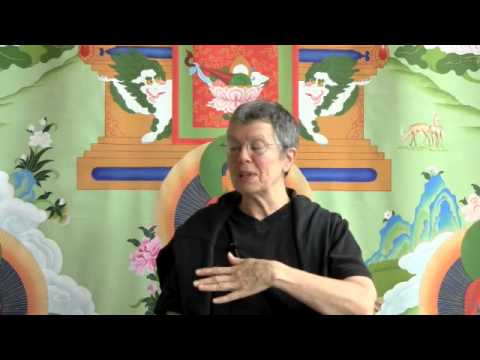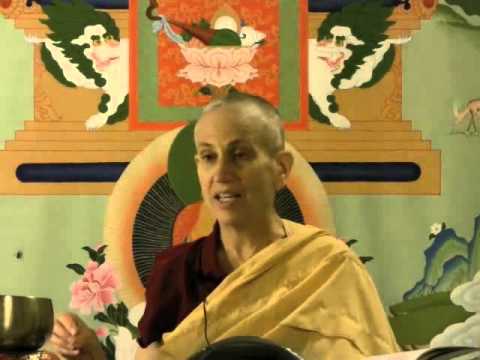Seeing through fears
Seeing through fears
Part of a series of Bodhisattva’s Breakfast Corner talks given during the Green Tara Winter Retreat from December 2009 to March 2010.
- Nervousness, negative thinking, and being overly sensitive may all be helped by the same approach
- The mind is often making projections, and we can recognize the negative habit of making mountains out of molehills
Green Tara Retreat 033: Seeing through fears (download)
We’re continuing to talk about fear. It’s pretty useless. I think if you were being chased by a dinosaur, then it might seem useful. But maybe you’d be better off to take refuge!
I don’t always recognize fear, but I do recognize other things. One of those is nervousness. I have three things that are all helped by the same approach: nervousness, maybe negative thinking, and being overly sensitive. In a way the things I use with these three experiences are very similar and all help.
One of them is recognizing that nothing is happening. My mind is oftentimes making a projection. Or if I’m thinking negatively, oftentimes it’s a negative habit. That’s actually just a habit. If I identify with that habit, it’s actually even worse because then it’s hard to get enough distance to work out of it. Sometimes it’s like making a mountain out of a molehill. Maybe there’s a little something there, but I’m just not thinking right. It’s like being on automatic in a way. What made me change is working with it in the way we had previously discussed, by just dropping it. Just drop it. Or just relax.
Actually, [at first] those things didn’t work very well for me. I found that what I was doing was looking at the things and having to kind of dispel them and realize that these are really wrong conceptions. Even that, I don’t actually believe this! When I really sit down and think about it, they’re just habits (mental habits that my mind will go to). Venerable Chodron once told me this. Because I was like,” Well, they just kind of keep coming and I can see the habitual part, but there’s also a part of your mind that actually believes in it still.” And so I think for me, it’s been helpful to spend time slowing down and recognizing that I actually am working through, “Well, do I believe this or not?” and getting very clear on that. Then when the thought comes up, it’s a little easier for me to drop it.
One day, I recognized that I was feeling unsafe and I hadn’t really seen that in these ways of thinking before. That was actually quite helpful because it made me go outside of my usual way of thinking and working with these experiences. I spent a couple of weeks just playing around with things. I remembered when I was a child (I think I was like eight or nine), and I used to hold my younger sister in my lap, and we would call this, “Taking her into my kingdom, come into my kingdom,” because she felt unsafe. I realized inside I needed to do that for myself: create this interior landscape. So I played around with this. When I looked at things, there’s no reason to feel unsafe. I could actually logically say that. But emotionally, that was kind of there. Part of that maybe connected some with nervousness. If you’re having negative thoughts about someone, you actually could feel unsafe—because you’re believing something negative which actually could cause you harm. So, there’s some logic to it. But still it didn’t seem like what I was doing was working. So when I just thought about this differently and got more creative, I decided I needed to create this space inside of myself. I allowed myself to do this by the thought that it was as valid as anything else. I allowed it to be valid. It was like this, “If I’m going to have these perceptions which even I don’t even believe, that are driving my behavior, why not at least come up with something that you actually have thought through, believe in, and want to be driving your behavior.” Basically from this I learned that I can drop things much easier once I’ve seen them clearly.
All this works better when I see a negative thought as its arising in my mind, which in retreat is a lot easier. Then I oftentimes will say to myself, “How wonderful!” and I’ll add a sentence on to it. For example, I’m seeing another person’s behavior and I’m having some judgment about it, and I don’t want to have that judgment. I’ve thought it through and know this is just an affliction. I’m seeing through this colored lens of affliction, and so I’m having this thought. And so I’ll just say, “How wonderful,” and then I’ll fill in with: “This is happening and how wonderful because … ” and I’ll make something up. Actually it’s not even like making up, “It is wonderful, how wonderful that … ” Maybe someone’s doing something that bugs you, and you can just say, “Well, how wonderful! This person’s exerting effort doing x, y or z,” They’re doing something virtuous and you’re having maybe a moment of jealousy or whatever. By just saying, “How wonderful … ” I need these things that are kind of quick and easy in the moment.
Lastly, another thing I do sometimes on the cushion but even like when we’re sitting at lunch—I find it really quite powerful (and I think it’s from years of doing the meditation where we visualize the refuge field) is to just sit and just look at the whole refuge field and feel like everybody is now in the correct relationship. It’s like with all the sentient beings around you, there’s this humanness—and it has a really opening feeling inside you of, “Here we all are. We’re all looking at the Buddha and the holy beings. We’re all having our own little problems or suffering this way or that, and here we all are.” It just puts everybody in the right perspective for whatever comes up. I don’t know why it is. I think maybe partly being in the presence of the holy beings. You can’t let your mind go too far south. But within this visualization then you can work with almost any of the lamrim teachings. Like, “Wow, somebody or something really bugged me, and so I’m having anger.” I can sit there and put us all in this surgical theater of the physician of the Buddha and just say, “Wow, look at the kindness of this person.” Look at them suffering and have compassion. Or, “See their kindness.” Or, any of the things that need to happen. For some reason when I do this pictorially in my mind’s eye it has a little more power; and it’s also kind of quick because the visualization is right there. If you’ve familiarized yourself with it, you can just draw it up and, all of a sudden, why feel unsafe? Everybody is in the proper relationship.
So, I don’t know if that works for you. But, I find it helpful to use some kind of creativity with things that are habitual. Good luck!
Venerable Thubten Tarpa
Venerable Thubten Tarpa is an American practicing in the Tibetan tradition since 2000 when she took formal refuge. She has lived at Sravasti Abbey under the guidance of Venerable Thubten Chodron since May of 2005. She was the first person to ordain at Sravasti Abbey, taking her sramanerika and sikasamana ordinations with Venerable Chodron as her preceptor in 2006. See pictures of her ordination. Her other main teachers are H.H. Jigdal Dagchen Sakya and H.E. Dagmo Kusho. She has had the good fortune to receive teachings from some of Venerable Chodron's teachers as well. Before moving to Sravasti Abbey, Venerable Tarpa (then Jan Howell) worked as a Physical Therapist/Athletic Trainer for 30 years in colleges, hospital clinics, and private practice settings. In this career she had the opportunity to help patients and teach students and colleagues, which was very rewarding. She has B.S. degrees from Michigan State and University of Washington and an M.S. degree from the University of Oregon. She coordinates the Abbey's building projects. On December 20, 2008 Ven. Tarpa traveled to Hsi Lai Temple in Hacienda Heights California receiving bhikhshuni ordination. The temple is affiliated with Taiwan's Fo Guang Shan Buddhist order.


